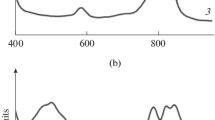Abstract
The predominance of the maximum at 800 nm for the light-harvesting complex LH4 (B800) and at 850 nm for LH2 (B800-850) from Rps. palustris is determined by the composition of αβ-polypeptides and pigments. In low light (LL) for Rps. palustris, strain KM 286 (1e5), along with LH4, the LL LH2 complex was synthesized with the same absorption at 800 and 850 nm. It differed from the LH4 and LH2 complex, which is synthesized under high illumination, in the composition and content of carotenoids (Car) and bacteriochlorophyll a (BChl a). LH4 differed from LL LH2 and LH2 by an additional emission maximum at 766 nm in the BChl a fluorescence spectra. All three complexes had approximately the same level (about 45%) of the energy transfer efficiency from Car to BChl a. Isolation of LL LH2 complex from Rps. palustris confirms the hypothesis of the synthesis in these bacteria under low light conditions of other types of complexes, except LH4, which is due to the multiple biosynthesis genes of αβ-polypeptides and the possibility of their various combinations.


Similar content being viewed by others
REFERENCES
Cogdell, R.J., Gall, A., and Köhler, J., The architecture and function of the light-harvesting apparatus of purple bacteria: from single molecules to in vivo membranes, Quart. Rev. Biophys., 2006, vol. 39, pp. 227–324.
Tadros, M.H. and Waterkamp, K., Multiple copies of the coding regions for the light-harvesting B800-850 α- and β-polypeptides are present in the Rhodopseudomonas palustris genome, EMBO J., 1989, vol. 8, pp. 1303–1308.
He, Z., Sundström, V., and Pullerits, T., Intermolecular hydrogen bonding between carotenoid and bacteriochlorophyll in LH2, FEBS Lett., 2001, vol. 496, no. (1), pp. 36–39.
de Ruijter, W.P.F., Oellerich, S., Segura, J.-M., Lawless, A.M., et al., Observation of the energy-level structure of the low-light adapted B800 LH4 complex by single-molecule spectroscopy, Biophys. J., 2004, vol. 87, pp. 3413–3420.
Taniguchi, M., Henry, S., Cogdell, R.G., and Lind-sey, J.S., Statistical considerations on the formation of circular photosynthetic light-harvesting complexes from Rhodopseudomonas palustris,Photosynth. Res., 2014, vol. 121, pp. 49–60.
Tharia, H.A., Nichtingale, T.D., Papiz, M.Z., et al., Characterisation of hydrophobic peptides by rp-hplc from different spectral forms of LH2 isolated from Rps. palustris,Photosynth. Res., 1999, vol. 61, pp. 157–167.
Hartigan, N., Tharia, H.A., Sweeney, F., Papiz, M.Z., et al., The 7.5 Å electron density and spectroscopic properties of a novel low-light B800 LH2 from Rhodopseudomonas palustris,Biophys. J., 2002, vol. 82, pp. 963–977.
Brotosudarmo, T.H.P., Kunz, R., Bohm, P., et al., Single-molecule spectroscopy reveals that individual low-light LH2 complexes from Rhodopseudomonas palustris 2.1.6. have a heterogeneous polypeptide composition, Biophys. J., 2009, vol. 97, pp. 1491–1500.
Brotosudarmo, T.H.P., Collins, A.M., Gall, A., et al., The light intensity under which cells are grown controls the type of peripheral light-harvesting complexes that are assembled in a purple photosynthetic bacterium, Biochem. J., 2011, vol. 440, pp. 51–61.
Serdyuk, O.P., Smolygina, L.D., and Khristin, M.S., Membrane-bound bacteriophytochrome-like complex of phototrophic purple non-sulfur bacterium Rhodopseudomonas palustris,Dokl. Biochem. Biophys., 2018, vol. 482, pp. 284–287.
Ashikhmin, A., Makhneva, Z., Bolshakov, M., and Moskalenko, A., Incorporation of spheroidene and spheroidenone into light-harvesting complexes from purple sulfur bacteria, J. Photochem. Photobiol. B, 2017, vol. 170, pp. 99–107.
Fixen, K.R., Oda, Y., and Harwood, C.S., Clades of photosynthetic bacteria belonging to the genus Rhodopseudomonas show marked diversity in light-harvesting antenna complex gene composition and expression, mSystems, 2016, vol. 1, no. 1. e00006-15.
Southall, J., Henry, S.L., Gardiner, A.T., et al., Characterisation of a pucBA deletion mutant from Rhodopseudomonas palustris lacking all but the pucBAd genes, Photosynth. Res., 2018, vol. 135, pp. 9–21.
Muzziotti, D., Adessi, A., Faraloni, C., et al., Acclimation strategy of Rhodopseudomonas palustris to high light irradiance, Microbiol. Res., 2017, vol. 197, pp. 49–55.
ACKNOWLEDGMENTS
We are grateful to M.S. Khristin, leading research associate of the Institute of Basic Biological Problems, Russian Academy of Sciences, for academic advice on the purification procedure of light-harvesting complexes.
Funding
The results were obtained under the State Assignment no. AAAA-A17-117030110141-2. Experiments on pigment analysis and assessment of efficiency of energy transfer from Car to BChl a were supported in part by the Russian Foundation for Basic Research (project no. 18-04-00684_a).
Author information
Authors and Affiliations
Corresponding author
Ethics declarations
The authors declare that they have no conflict of interest. This article does not contain any studies involving animals or human participants performed by any of the authors.
Additional information
Translated by M. Batrukova
Rights and permissions
About this article
Cite this article
Serdyuk, O.P., Smolygina, L.D. & Ashikhmin, A.A. A New Type of Light-Harvesting Complex Detected when Growing Rhodopseudomonas palustris under Low Light Intensity Conditions. Dokl Biochem Biophys 491, 101–104 (2020). https://doi.org/10.1134/S160767292002012X
Received:
Revised:
Accepted:
Published:
Issue Date:
DOI: https://doi.org/10.1134/S160767292002012X



